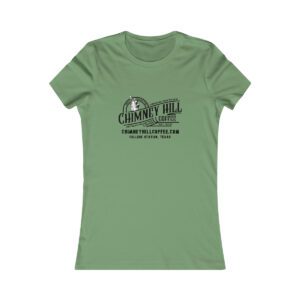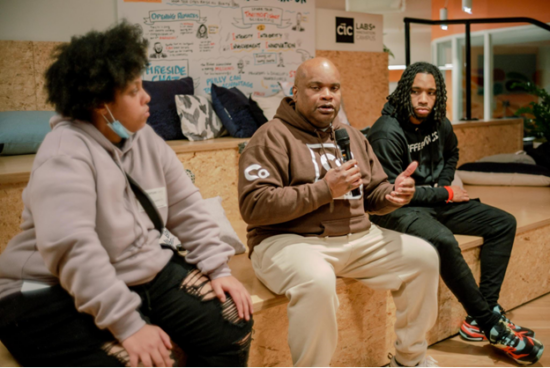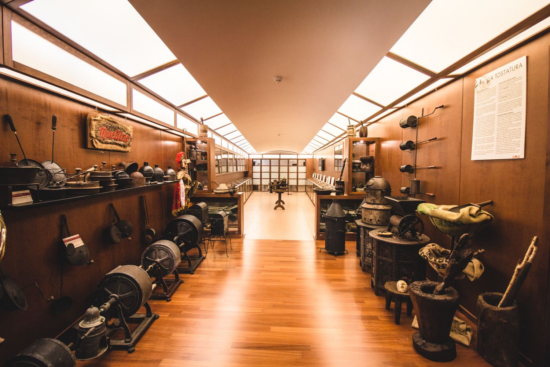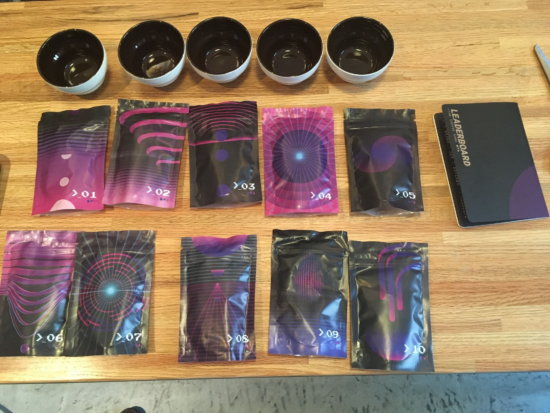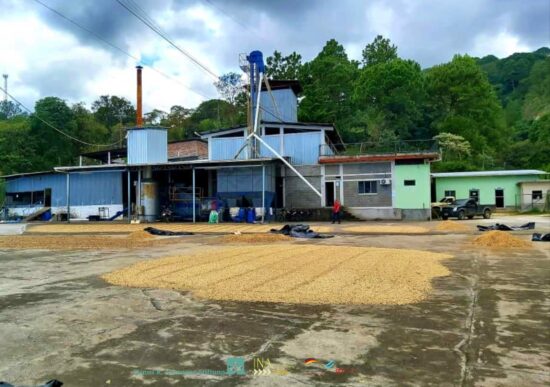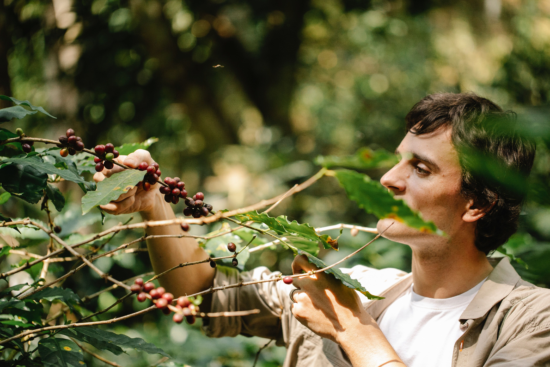This is the absolute fastest way to make French press iced coffee. Just forget about cold brew concentrate – with this Quick French Press Iced Coffee Recipe you can have your iced coffee ready in 5 – 6 minutes. Who doesn’t like the French press?! It’s...
Cupping at Home Part Two: How to Host a Home Cupping for Friends and Family
Cupping at Home Part Two: How to Host a Home Cupping for Friends and Family
Cupping at Home Part Two: How to Host a Home Cupping for Friends and Family
Cupping at Home Part Two: How to Host a Home Cupping for Friends and Family
Cupping at Home Part Two: How to Host a Home Cupping for Friends and Family
Cupping at Home Part Two: How to Host a Home Cupping for Friends and Family
I Tested Keurig K Compact – Here’s Everything You Need To Know
The most affordable Keurig coffee maker is available exclusively at Walmart and comes at a sweet price of only $59.00. In this article, you’ll find out how good it really is, and also find additional information like how to clean it, or do you need a water...
Here’s How to Change Keurig 2.0 Water Filter Easily
Not sure how to change Keurig 2.0 water filter? Here are step-by-step instructions that will help you do it quickly and easily. Keurig water filter should be changed every 2 months or 60 tank refills. The water filter is located inside the water tank, on the valve at...
The coffee rose for assessing Anaerobic coffee
I just came across this really neat tool to assess anaerobic coffees. I haven't used it for cupping yet. I'm not sure I will like it either because the idea of lowering the score of the coffee just because it tastes has some thyme flavors. At the same time I...
Three US Coffee Championship Events Are Heading To Rancho Cucamonga
This article is from the coffee website Sprudge at http://sprudge.com. This is the RSS feed version. The 2024 US Barista Championship, Brewers Cup, and Cup Tasters will take place March 15-17 at Klatch Coffee Roasters in Rancho Cucamonga, California.
The Origin Story of Turtle Island Coffee in Vancouver, B.C.
A new Indigenous-owned coffee company based in Vancouver, British Columbia, called Turtle Island Coffee has launched with the goal of exposing more people to high quality specialty coffee and Indigenous...
Get Ready for The Barista League’s 2024 Season
The Barista League has announced 12 competitions across four continents. BY J. MARIE CARLANBARISTA MAGAZINE ONLINE Photos courtesy of The Barista League When The Barista…
Get Ready for The Barista League’s 2024 Season
The Barista League has announced 12 competitions across four continents. BY J. MARIE CARLANBARISTA MAGAZINE ONLINE Photos courtesy of The Barista League When The Barista…
Get Ready for The Barista League’s 2024 Season
The Barista League has announced 12 competitions across four continents. BY J. MARIE CARLANBARISTA MAGAZINE ONLINE Photos courtesy of The Barista League When The Barista League announces new events, it’s worth paying attention! This year, the schedule will be...
Weekly Coffee News: EUDR and Africa + More Celebrity Coffee
Welcome to DCN’s Weekly Coffee News. Keep up with all the latest coffee industry stories and career opportunities by subscribing to DCN’s newsletter. Tell our editors about your news here. Report: Small-Scale Farmers in...
Do Higher Coffee Prices Mean More Money For Farmers? A Story From Sumatra Shows It’s Complicated
This article is from the coffee website Sprudge at http://sprudge.com. This is the RSS feed version. Since coffee costs more now than ever, do those coffee prices impact the amount of money earned by coffee farmers?
Coffee News Recap, 2 Feb: Applications open for Australia’s Richest Barista 2024, De’Longhi reports 4.6% revenue increase after La Marzocco move & other stories
Every Friday, Perfect Daily Grind rounds up the top coffee industry news from the previous week. Here are this week’s coffee news stories. The word of the week is: expansion. Mon, 29 Jan AeroPress launches limited-edition Clear Pink brewer. The coffee brewer is made...
Watch The 8 Best Coffee Videos Vying For Sprudgie Awards
This article is from the coffee website Sprudge at http://sprudge.com. This is the RSS feed version. The best coffee videos from 2023 featuring Cafe Imports, Aramse, Nguyen Coffee Supply, Wildly, Mirror Coffee Roasters, Alto Stories, Quek Shio, and Cafe Retiro.
Robusta is great and has untapped potential
I live in the US and my typical choice of coffee is lightly roasted Ethiopian pour overs. I generally love acidity and fruit flavors in my coffee. My experience with Robusta has often been poor. Very dark, roasty and maybe chocolatey. I participated in the Hoffman...
Design Details: Brewing Reinvented at ULA Café in Melbourne
Welcome to Design Details, an ongoing editorial feature in Daily Coffee News focused on individual examples of coffee shop architecture, interior design, packaging design or branding. If you are a coffee...
Robert Downey Jr.’s New “Happy Coffee” Is Really Depressing
This article is from the coffee website Sprudge at http://sprudge.com. This is the RSS feed version. Robert Downey Jr. and Craig Dubitsky team up for Happy Coffee.
Out Now: The February + March 2024 Issue of Barista Magazine!
In our new issue we feature Lisa Lawson from Glasgow, Scotland, take a look at the newest grinders, explore spring drink inspiration, see how more women are getting involved in coffee tech, and much more! BY SARAH ALLENBARISTA MAGAZINE We’re stoked to announce the...
The coffee industry’s biggest competition: The story of the World Barista Championship
Every year, the global coffee industry gears up for one of its most exciting and groundbreaking competitions: the World Barista Championship. For more than two decades, the WBC has been one of the biggest catalysts for change and innovation in specialty coffee, and...
The 2023 Specialty Coffee Transaction Guide Has Landed
The 2023 edition of the Specialty Coffee Transaction Guide (SCTG) guide went live today, providing actors throughout the coffee chain a data-driven tool for green coffee price discovery. The full...
Espro great until I needed replacement filter ☹️
I've had an Espro P7 for nearly four years after seeing glowing praise on this sub (to which I later contributed). Before I bought the P7 I looked at the replacement parts available and they seemed like a solid company in that they sold e.g. replacement filters...
New Bill Requires More Kona In Your Kona Coffee
This article is from the coffee website Sprudge at http://sprudge.com. This is the RSS feed version. Currently a coffee only need to be 10% Kona to be labeled as such.
What’s the best and worst part about owning and running a coffee shop?
I'm not interested in getting into it myself, as I have no experience in the service industry, no real appetite for risk and no desire to run a business in general. But sometimes I think about it and I wonder what's the most enjoyable thing about it and...
minimum dose size?
I use the Hario switch to brew my coffee and am trying to reduce my caffeine consumption. Hence I would like to brew smaller cups of coffee. I am currently using 10g of coffee with 160g of water. (1:16 Ratio) I am wondering if there is a minimum amount of coffee...
[CAFE OWNERS] Background before starting a shop?
I’ve worked in coffee for 6 yrs as a barista and shift supervisor and have passion for it. I’ve decided that I want to open my own place in the future and so I’ve been doing the research to make a business plan. Lately, however, I’ve begun to realize just how many...
Cupping at Home Part Two: How to Host a Home Cupping for Friends and Family
Organizing a coffee cupping with friends and family can be the perfect way to start learning more about coffee while having fun at the same time (and drinking a lot of coffee, of course).
BY TANYA NANETTI
SENIOR ONLINE CORRESPONDENT
Cover photo by Tanya Nanetti
Thanks to its easy and repeatable procedure, cupping at home is a great way to try new coffees and compare them, start recognizing new flavors and new characteristics, and delve into the marvelously complex world of coffee.
You don’t need many tools to organize a cupping; if you’re already a coffee brewer, you probably have a lot of them on hand!
What You’ll Need
- A kettle (if you have one with temperature control, even better)
- A scale
- A coffee grinder
- Cups or bowls (as many as there are coffees to try, all of the same size and shape, about 200/220ml)
- Spoons (one per person)
- A timer
- Two or three glasses full of hot water (to rinse the spoons)
- Some spitting cups
- Drinking water and cups
- Flavor wheel (optional)
- Coffee, as many bags as you want to try—about five to seven coffees from different origins, possibly processed differently, is a good starting point


Getting Started
Begin by preparing in a straight line as many cups as you want to use for cupping, one for each coffee. Label the bottom to be sure that if something happens and the cups get mixed up, you will still know which coffee was in which cup.
Grind the coffees slightly coarser than your classic pourover size (around 25 clicks on the Comandante should be fine), put each coffee in its own cup, and smell.
Meanwhile, heat the water. If your kettle has temperature control, 92°C (198°F) is perfect. Otherwise, let the water boil and then wait two minutes before pouring it to let it cool down a bit.
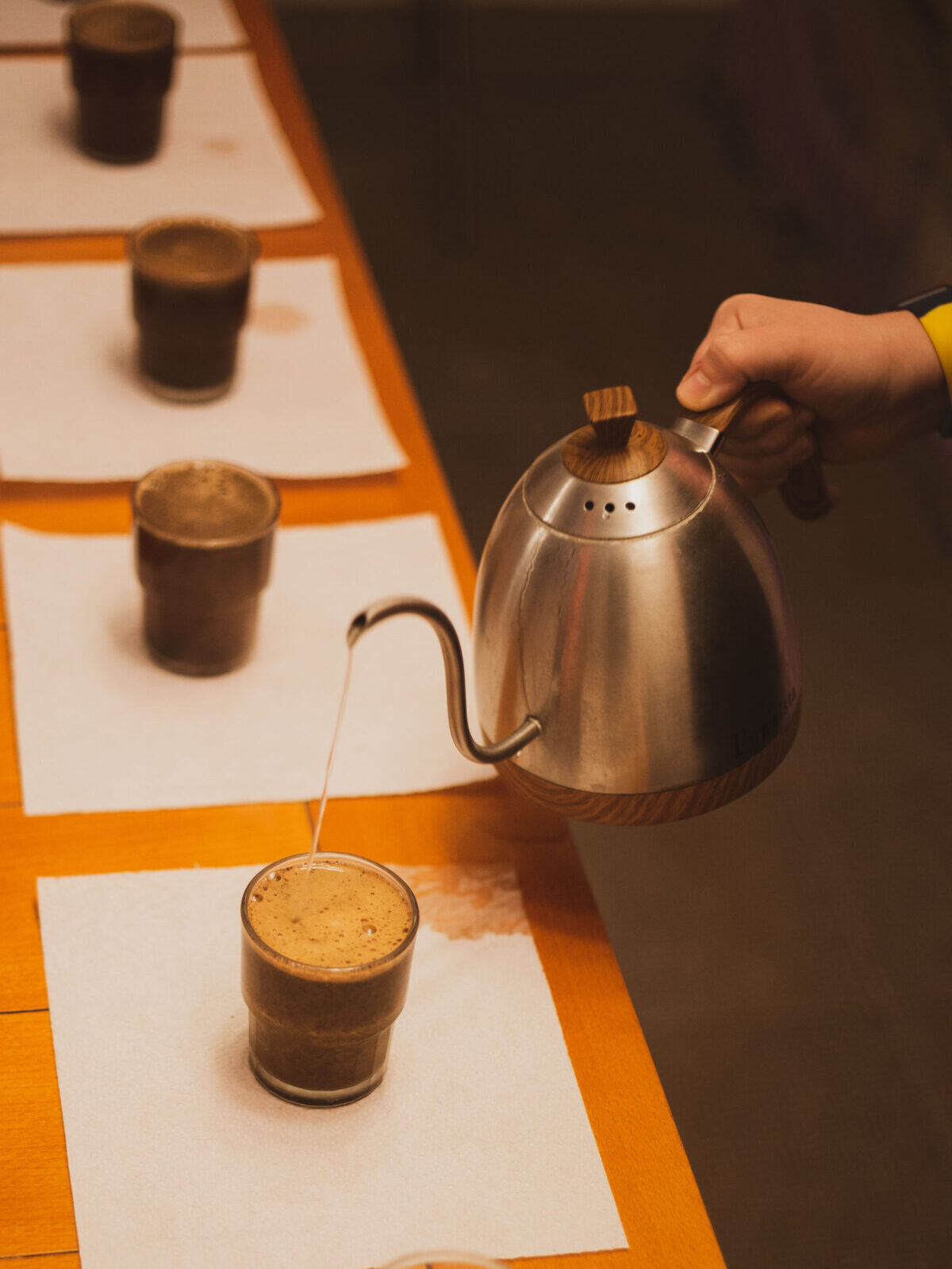

Pouring
Start the timer and begin pouring the water on the first coffee, working down the line and pouring the water always in the same style. Fill each with a 17:1 ratio of water to coffee. Note that if you have a lot of coffees, one kettle of water won’t be enough, so be prepared to ask someone to heat up some extra water as you start pouring.
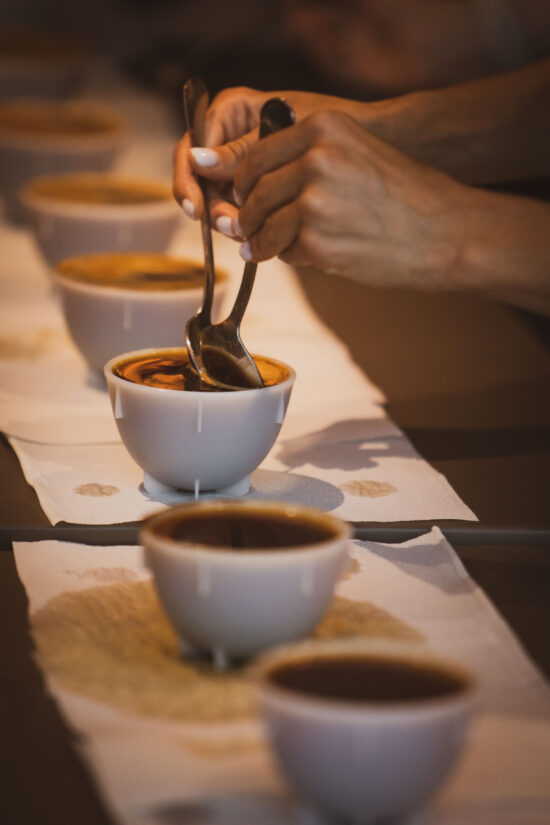

Breaking the Crust
When the timer reaches four minutes, break the crust on top of the cups with the back of a spoon: when the crust breaks, the coffee will release gasses. Don’t forget to smell, trying to catch some aromas. Then, using a second spoon, remove the crust. Do the same for each coffee, following the line.
Tasting
When the timer reaches 10 minutes, it’s finally time to start tasting. Take a spoonful of the first coffee and slurp quickly: This will help to better spread the coffee throughout your mouth, so you can taste more aromas and flavors. Repeat for all cups following the line, remembering to rinse the spoon after each tasting.
Taste each coffee several times until it cools down; this way you’ll be able to notice how a coffee differs when it cools down. Along the way, remember to always keep yourself hydrated by drinking enough water. And if the coffee starts to be too much, don’t be ashamed to use a spitting cup to spit after tasting.
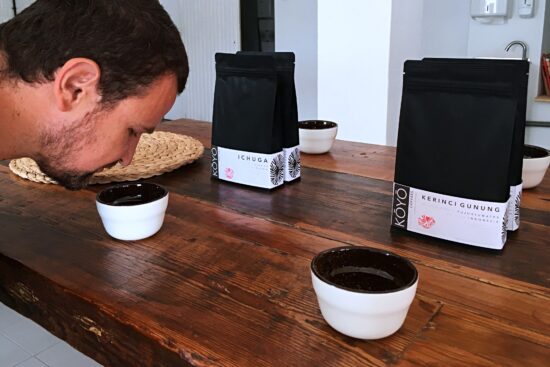

Savor the Flavors
What should you be looking for? Start with the basic characteristics: acidity, bitterness, and sweetness. Think about the body: Is it thin? Does it have a velvety mouthfeel? Consider the roasting and the aftertaste. (Does it linger? Is it bitter or sweet?)
Along the way, start to note any flavor you may recognize: Having one of the many versions of the Flavor Wheel at hand, easily available online like the one proposed by Counter Culture Coffee, can really help.
Just start from the center, and try to categorize any flavor you can taste. Is it something that reminds you of chocolate? Or maybe more of some kind of fruit?
Then, after you’ve figured out a macro category, try to get more specific. Maybe the fruity flavor you discovered really tastes like tropical fruit. Could it be mango? Or maybe coconut?
And so on.
This is just a basic cupping procedure—perfect for spending a couple of hours with friends and family having fun and learning about coffee—but there are many different ways to “upgrade” the cupping experience.
Some Variations
Try two cups of each coffee, to compare them, and see if they differ in some way. Or try a blind cupping (where you don’t know which coffee you’re tasting because you’ve mixed the cups on the table). This can be a fun way to dig deeper into tastes as you try to guess which coffee is which.
Another option: Try the professional method, tasting the coffees while filling out a tasting form. Use a flavor profile form or the official SCAA form; there are many different versions that can help you put your thoughts in order, giving you a clearer idea of what you’re cupping.
The more you cup, the more you’ll learn. But don’t forget that what you’re doing is not a competition, just a nice way to learn more about coffee, and of course, have fun with friends!
ABOUT THE AUTHOR
Tanya Nanetti (she/her) is a specialty-coffee barista, a traveler, and a dreamer. When she’s not behind the coffee machine (or visiting some hidden corner of the world), she’s busy writing for Coffee Insurrection, a website about specialty coffee that she’s creating along with her boyfriend.
The post Cupping at Home Part Two: How to Host a Home Cupping for Friends and Family appeared first on Barista Magazine Online.



